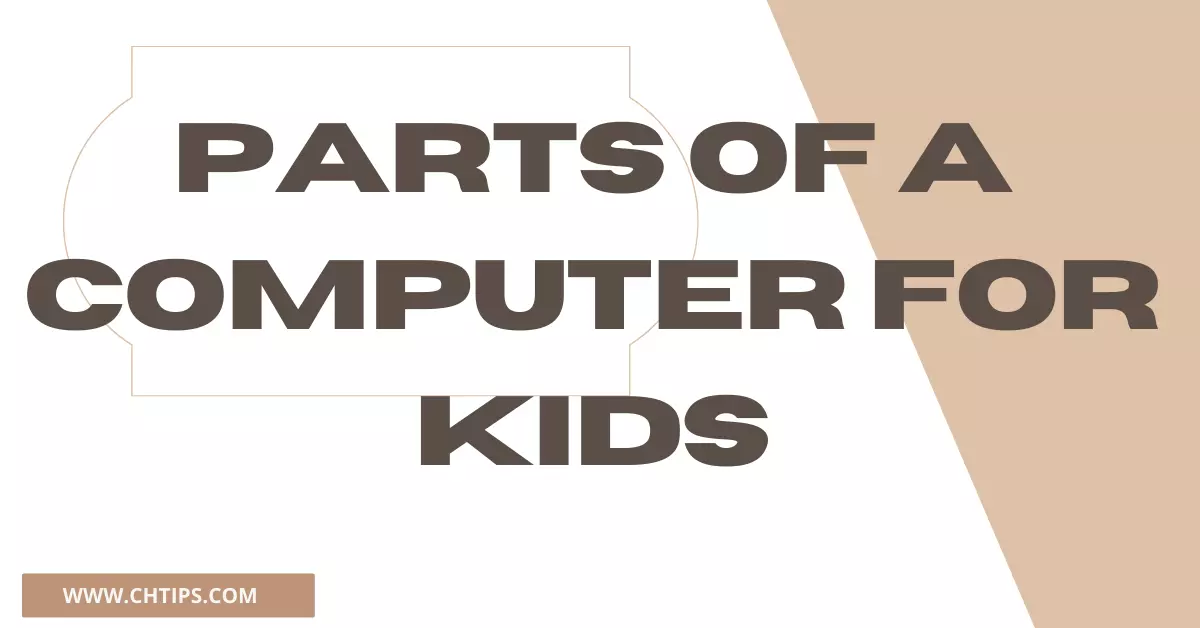In today's post, we will learn and discuss the 10 basic parts of a Computer for kids with images definitions, examples, descriptions also with diagrams, and pictures.
Let us try to understand computer systems in easy-to-understand language with illustrative examples.
A computer is nothing but an electronic device designed and developed to perform some mathematical and logical calculations with great speed and unbelievable accuracy.
The Computer was invented by Charles Babbage, also known as the "Father of Computer".
Let us dig into the topic more briefly.
What is a Computer System
The Computer is an electronic computational device capable of performing arithmetical, mathematical, and logical operations.
The Computer can store and hold a huge amount of data and information almost permanently.
The information and data stored in computer storage devices can be recalled whenever users request and demand. The modern Computer can store unbelievable data which is beyond human capabilities.
The term computer is derived from the Latin term ”Computare”, which means to calculate.
Computers can also be called programmable machines.
In other words, computers can store, retrieve, and process data with speed and precision.
According to their size and capabilities, computers are classified into four different types.
- Super Computer
- Mainframe
- Mini
- Micro
10 Basic Parts of a Computer for Kids With Images
Let us try to understand 10 basic parts of a computer system for kids With images.
The computer parts are categorized into two basic types they are
- Input Devices.
- Output Devices.
- Storage Devices.
Here I have listed some of the major parts of a computer system.
- Monitor
- CPU {Central Processing Unit}
- Keyboard
- Mouse
- Printer
- Scanner
- Webcam
- Joystick
- Speakers
- CD
- DVD
- Pen Drives
- Webcam
- Head Phone
- Hard Disk
- Processor
- Pen Drives
- Motherboard
10 Input Devices of Computer System With Examples
List of some input devices of Computer.
- Mouse
- Keyboard
- Scanner
- Trackball
- Joystick
- Light Pen
- Touch Screens
- Optical Card Reader (OCR)
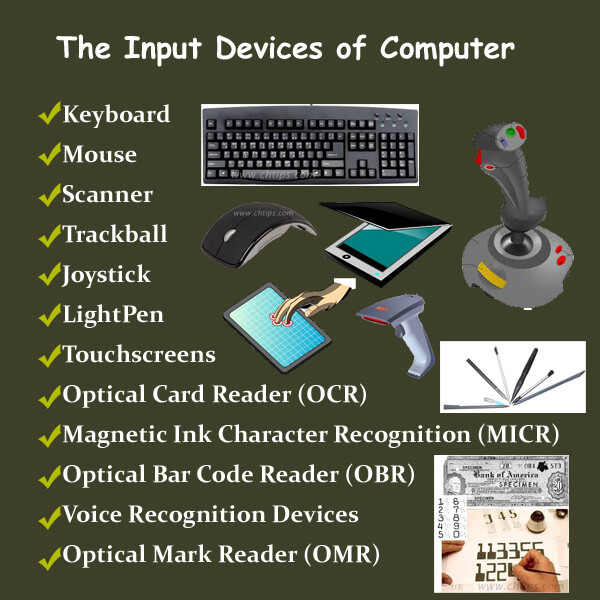
The input devices of a computer system can be described and explained as electromagnetic devices that accept information and data from outside the world and translate this given data and instruction into machine language that machines or computers can easily understand.
This machine language is also known as "Binary Language," which uses 0s and 1s for processing and understanding.
The input devices of computers act as a bridge between Computers and users.
The data presented to the Computer are translated and processed for further use; this data can be saved in computer memory almost permanently.
The computer keyboard and mouse are considered to be prime examples of input devices.
Let us discuss input devices in more detail.
1. Mouse
The computer mouse is a pointing device used to point to a certain area on the screen and also to click and drag files and folders from one location to another.
The mouse is the most well-known and famous pointing device, which has two clickable buttons, one on the right side and the other on the left side, and a wheel in the center for scrolling.
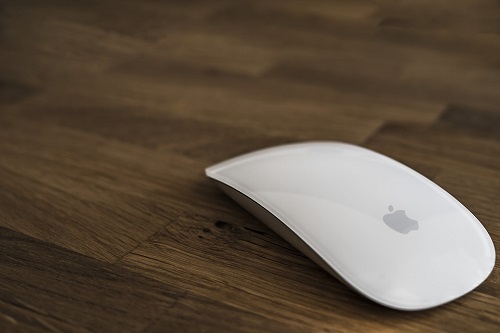
The mouse is utilized fundamentally in applications or projects or with GUI Technology (Graphical User Interface).
The mouse is relatively inexpensive and the most used input device also primarily used in GUI {Graphical User Interface} applications.
There are three types of the mouse
- Mechanical Mouse
- Optical Mouse
- Infrared (IR) or radio frequency cordless mouse
2. Keyboard
The keyboard is primarily used for entering data, information, and instructions into the computer system.
With the mouse, the keyboard is also considered one of the most used input devices.

The modern Computer’s keyboard consists of numerous keys; some keys are used to enter numeric values.
Some are used to enter alphabets, and also used for entering special keys and special symbols.
Some multimedia keys are used to play sound and videos.
The standard keyboard has 101 keys, but today, the keyboard comes with 102 and 124 keys for better and enhanced performance.
There are three types of keyboard
- Normal Keyboard.
- PS/2 Keyboard.
- USB keyboard.
- Wireless Keyboard.
3. Scanner
The scanner is also considered to be the input device of the Computer.
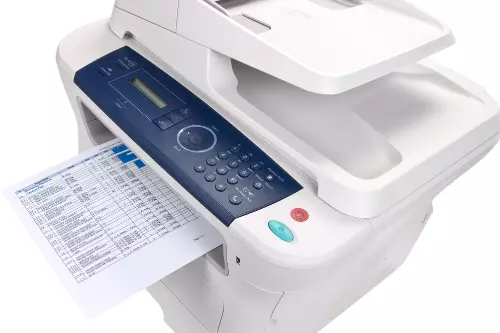
The scanner is used to scan any document like images, pictures, documents, and text on paper and later can be stored on a computer hard disk permanently.
There are 2 types of scanners
- Hand-Held Scanners
- Flatbed Scanners
4. Trackball
The trackball is a pointing device, just like a mouse.
The trackball usually is built-in with laptops and notebooks. They are used to navigate on the area of the screen horizontally, and diagonally also are free movers.
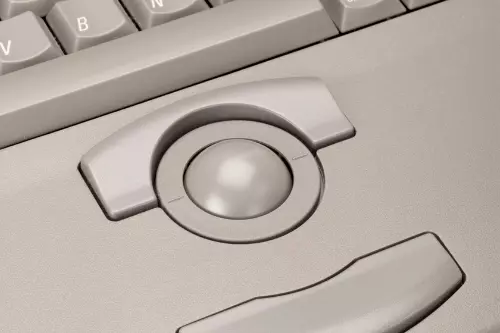
Fingers use a trackball to select, click, and drag files and folders from one location to another.
They are small in size, more often square in shape. It is very easy and efficient to use and can be installed in less space.
5. Joystick
The joystick is famously used for playing games and in CAD {Computer Aided Design}.
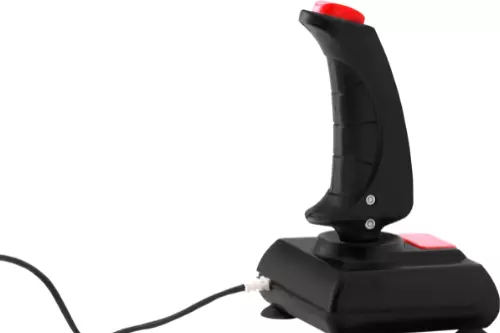
In the modern keyboard, a joystick is pre-installed.
The joysticks can move LEFT, RIGHT, UP, DOWN, and a push-button at the top.
6. Light Pen
The Light pen is a pointing device and one of the input devices that looks similar to a pen.
They are equipped with light sensors that are activated when it is touched or used.
It is used for choosing and drawing pictures; it sends a flag and PC, which distinguishes the cursor’s position.
7. Touch Screens
Touch screens are capable of displaying and retrieving data and information on the net.
Touch might be known as touching the screen with fingers. They can be detected by fingers or pen-shaped stylus.
8. Optical Card Reader (OCR)
OCR is a mechanical or electronic gadget or device that can translate images, pictures, documents, or manually written content into coherent machine shapes.
OCR also works like a scanner that can check documents, pictures, images, and composed content and can store it in memory, which later can be contrasted with the previously stored data.
Useful Video On: Basic Parts of a Computer for Kids
10 Output Devices of Computer System With Examples
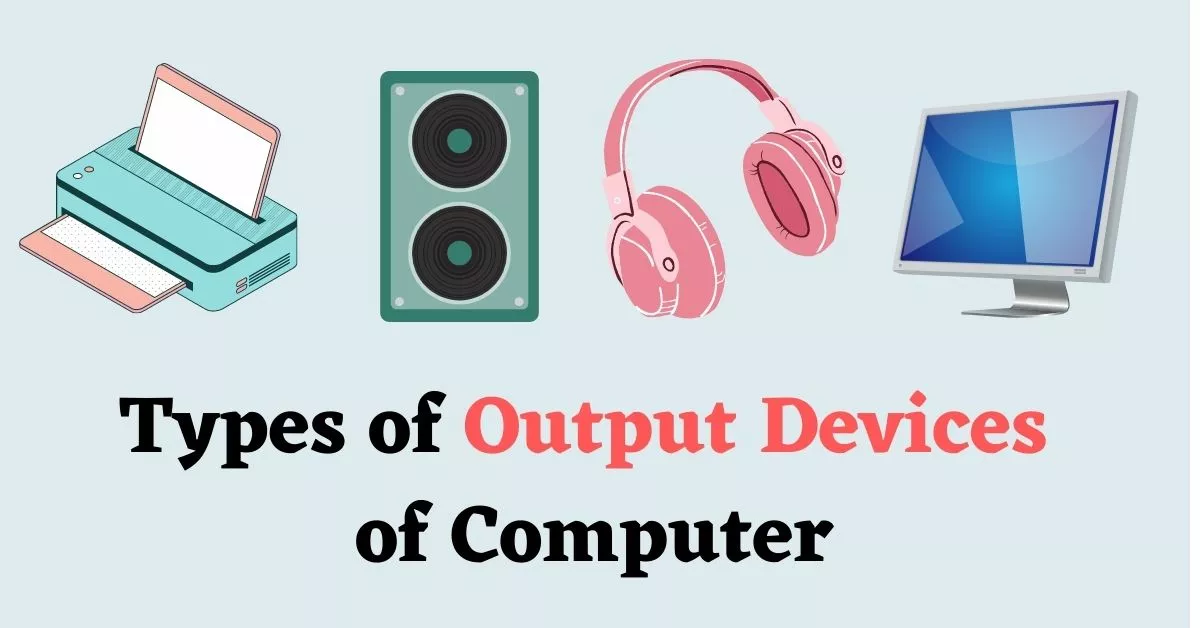
The Output Devices of a Computer System are electromagnetic devices that receive data or information from the computer system and convert the data into a human-readable or intelligent form.
Generally, the output can be obtained mainly in two distinct and different ways: softcopy and Hardcopy.
Here we will discuss and list some of the famous output devices of computers which are also known to be the parts of computers used by kids, younger people, and professionals.
- Monitors
- Touch Screens
- LCD Monitors or LED Monitors
- Printers
- Speakers
- Headphones
- Sound Cards
- Plotters
- Projectors
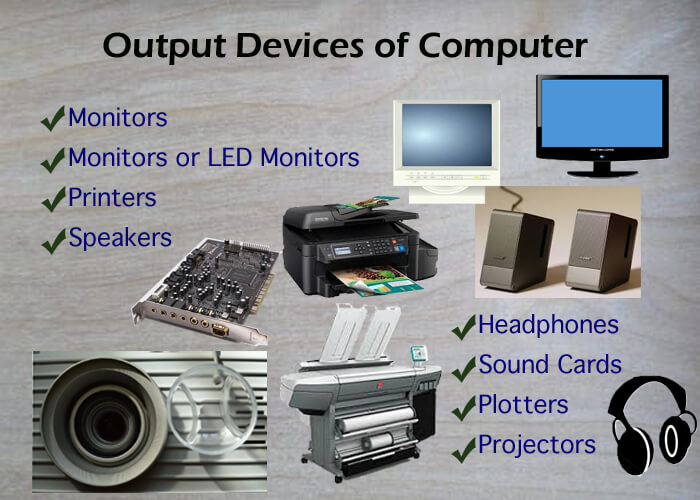
1. Monitors
The monitors are the most used output device of a computer system.
They are also known as VDU {Visual Display Unit}. These screens are huge, require more power, and need a lot of space for installation.
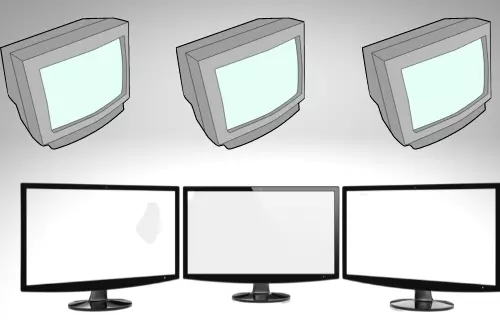
The old monitors look similar to television.
The screens are primarily used to display the output from computer memory. They present softcopy.
2. Touch Screens
Touch screens are one of the types of output devices of computers.
Touch Screens are well known for displaying data and information to the user. They do not require any input device to present the data, like a keyboard or mouse.
3. LCD Monitors and LED Monitors
The Full Form of LCD is Liquid Crystal Display, and LED stands for Light Emitting Diode.
LCDs and LEDs are used in the monitor screen of Computers and laptops.
They are smaller and more compact and also need less power compared to CRT monitors. They are compact and therefore need less space for installation.
All the new and updated desktops and laptops are equipped with these modern technologies.
4. Printers
There are mainly two types of printers
- Impact Printers.
- Non-Impact Printers.
Printers are the most used and important output device of the computer system. They are computer peripheral devices that produce output on paper, which are called HARDCOPY.
Printers are connected to the Computer or laptops with the help of USB {Universal Serial Bus} or with any serial connectors.
5. SPEAKERS
The Speakers are multimedia devices that are used to play sound. They are capable of converting electrical signals to sound.
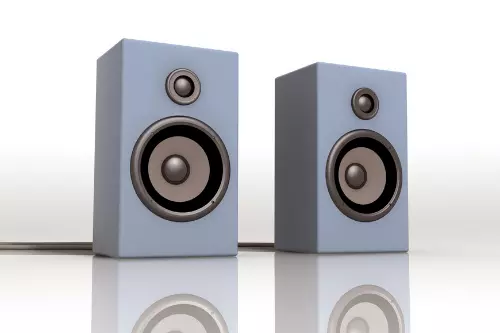
The speaker can be connected to a computer or laptop to listen to the sound. These speakers can be connected to the USB port.
6. HEADPHONES
The Headphones are used to hear sounds from computers and laptops.
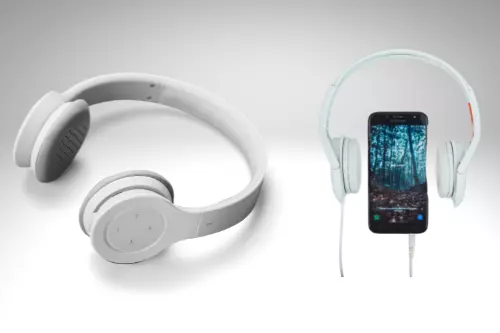
Using earphones, clients can play and hear sound music, songs, and recordings. The users can converse with PCs; they can interpret advanced signs into simple signals.
In Simple Words, they can translate or convert digital signals into analog signals.
7. Plotters
Plotters are similar to printers; they are used and utilized in drawing illustrations, diagrams, construction maps, architectural plans, engineering drawings, business charts, and 3D printing.
They are also used in printing charts rather than alphanumeric characters.
It has been found that plotters are quite expensive when compared to printers.
There are two types of plotters
- Pen Plotters.
- Electrostatic Plotters.
Related Articles
- 10 Uses of Computer in Different Fields With Pictures
- 10 Limitations of Computer System
- 10 Uses of Multimedia in Different Fields
- What is Booting in Computer | Types of Booting in Computer
- Types of Secondary Memory in Computer
- Characteristics of Fourth Generations of Computer
- What is Versatility In Computer Systems
- Smallest Unit of Computer Memory
- Advantages and Disadvantages of Speakers
- Advantages and Disadvantages of IGBT
- Essential Attributes of Good Software
- How Do Computers Works at the Most Basic Level
- Characteristics and Features of Fifth Generation Computer
- Which Generation of Computer is Still Under Development
- What is the Evaluation of Information System?
- What are the Processing Devices of Computer
- What is Napier Bones in Computer System
- What is Buffered Memory and Their Differences
Storage Devices of Computer
Hard Disk
Computer hard disk drives are the most popular secondary storage devices of the computer system.
They are the most crucial part of the Computer where all the essential data and information are saved permanently.
Computer Hard disk was first introduced in 1956 for IBM.
SSD
SSD stands for Solid State Device.
The SSD uses NAND-based flash memory.
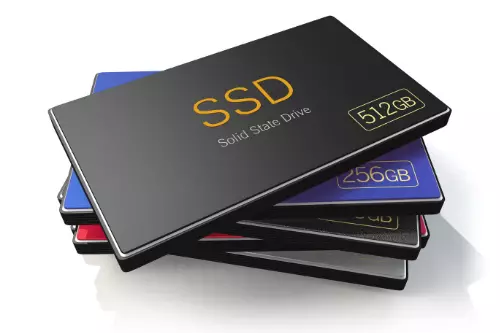
They are non-volatile memory and can store and handle a massive amount of data and information permanently.
Pen Drives
They are portable devices; therefore, they can be easily carried from one location to another. They have a very compact shape and size and sometimes look like a pen shape.
Therefore they derived the name pen drive.
Computer Memory
The primary memory of a computer system is volatile.
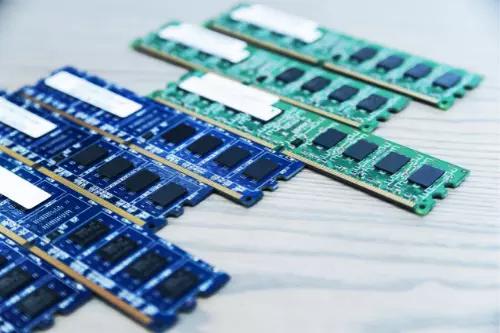
The data and instructions are lost from the memory when there is a power loss, and we cannot retrieve the data after the power interruption.
They are also “Read Only Memory” and cannot store or hold data and instructions permanently, therefore known as “Temporary Memory“.
Basic Parts of Computer System
| # | Computer Parts |
| 1 | Central Processing Unit [CPU]. |
| 2 | Motherboard |
| 3 | Hard Disk |
| 4 | Computer Cabinet |
| 5 | Switching Mode Power Supply [SMPS] |
| 6 | RAM [Random Access Memory] |
| 7 | Keyboard |
| 8 | Mouse |
| 9 | Monitor |
| 10 | Printers |
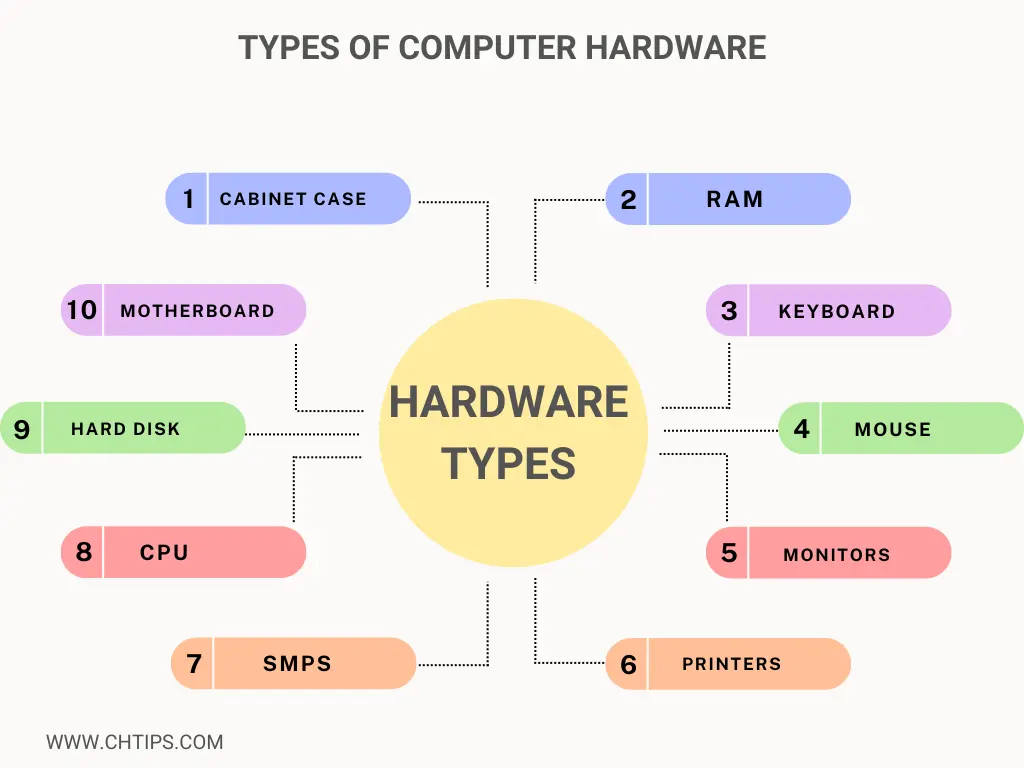
What are the 3 Computer Fundamentals?
- Input
- Output
- Processing
- Storage
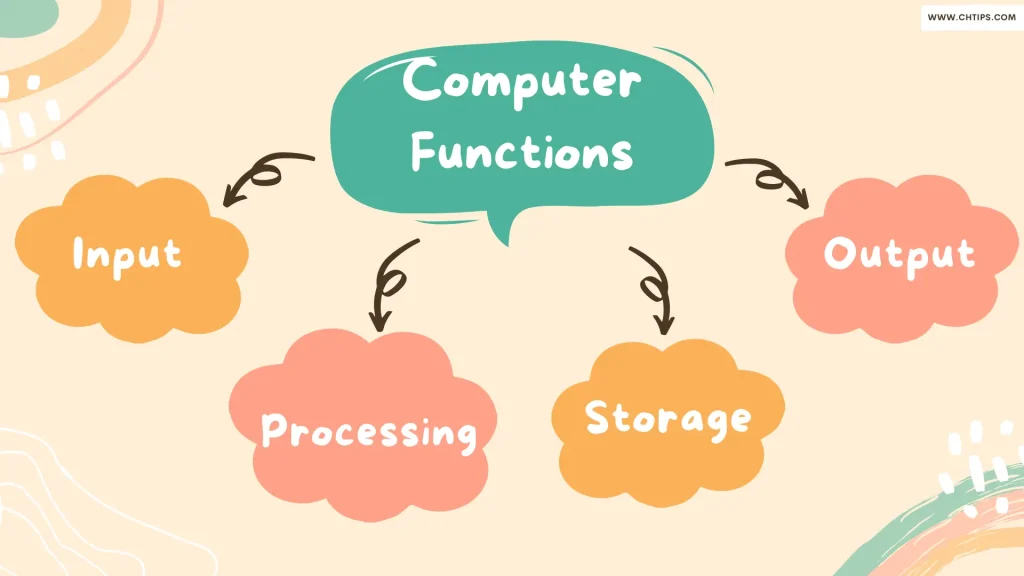
Functions of Computer System
- Arithmetic and Logic Unit.
- Control Unit.
- Central Processing Unit [CPU]
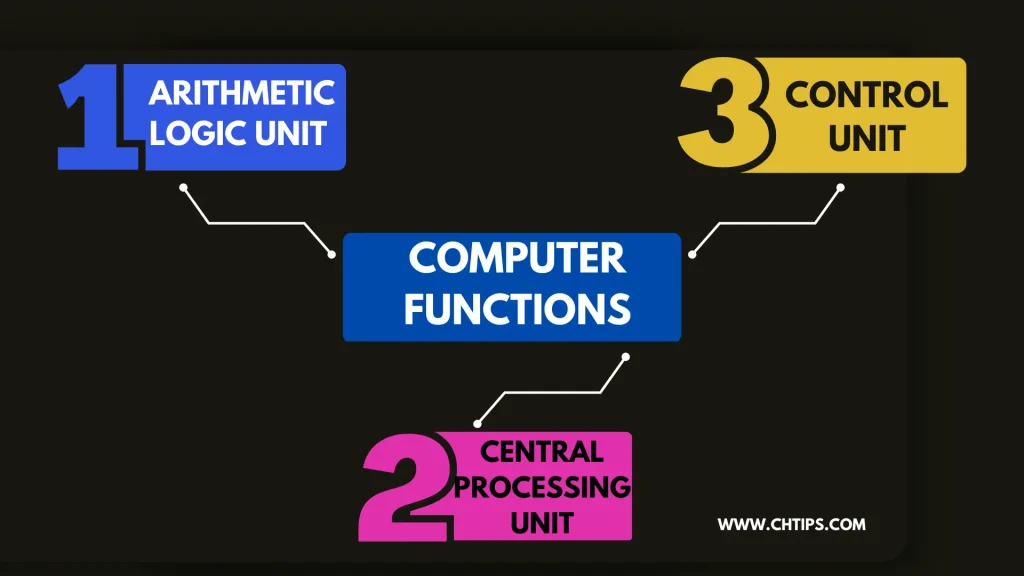
Block Diagram of Computer System With Diagram
The Computer System can be categorized mainly into three types they are as follows.
- Input Devices
- Output Devices
- Central Processing Unit
The central processing unit future is more divided into ALU { Arithmetic and logic Unit } and Control unit.
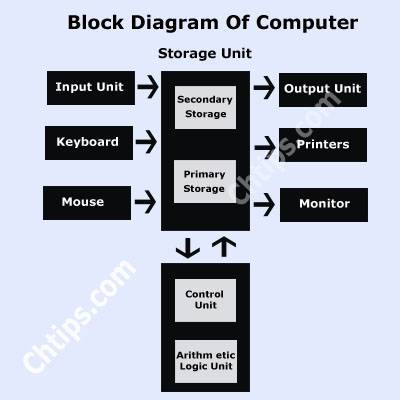
The input device allows the user to enter the raw data into the Computer with the help of a keyboard and mouse.
Later this set of instructions is processed with the help of the CPU [Central Processing Unit], and the computer system produces an output using output devices like printers and monitors.
A large amount of data is stored in computer memory with the help of primary and secondary storage devices temporarily and permanently.
These are called storage devices.
People Are Also Reading
- What are Input Devices of Computer
- 9 Types of Pointing Devices
- What is Block Diagram of Computer System
- Advantages and Disadvantages of Magnetic Disk
- Advantages and Disadvantages of Optical Disk
- Advantages and Disadvantages of Microprocessor
- 20 Advantages and Disadvantages of Mobile Phones
- Advantages and Disadvantages of CRT Monitors
- Advantages and Disadvantages of CCTV Cameras
- Advantages and Disadvantages of Fifth Generations of Computer
- Differences Between LCD and OLED Screens
- Computer Basic Tutorials
Frequently Asked Questions [FAQs]
What are the Main Parts of Computers for Kids
Monitor.
CPU.
Keyboard.
Mouse.
Speaker.
What are the 5 Basic Parts of a Computer
Motherboard.
Central Processing Unit (CPU)
Graphical Processing Unit (GPU)
Random Access Memory (RAM)
Storage device.
What are the Four Basic Computer Skills
Input, Processing, Storage, and Output
What are the 3 Computer Fundamentals
1) Arithmetic Logical Unit, 2) Control Unit and 3) Central Processing Unit.
Five Basic Operations of a Computer
inputting, processing, outputting, storing, and controlling.
What are the Two Input Devices?
Keyboard and Mouse
Two Output Devices of Computer
Monitor and Printers
Get In Touch
I have also written and compiled some articles on computers and telecommunications, and please go through them.
I hope you will like reading it.
I hope that all the questions and queries related to 10 Basic Parts of a Computer for Kids With Examples have been answered here.
Don’t hesitate to get in touch with me, and if you need to add, remove or update anything from the article, please let me know in the comment section or via email.
I will be more than happy to update the article. I am always ready to correct myself.
Please share this article with your friends and colleagues; this motivates me to write more related topics.
!!! Thank You !!!
